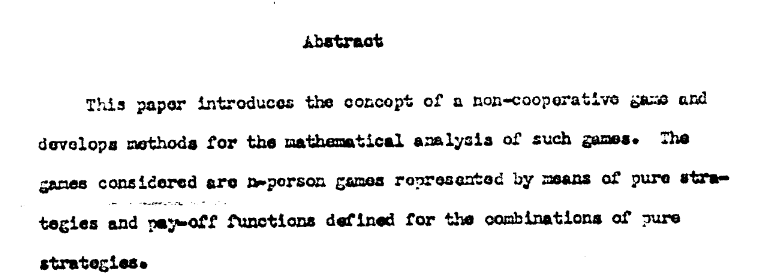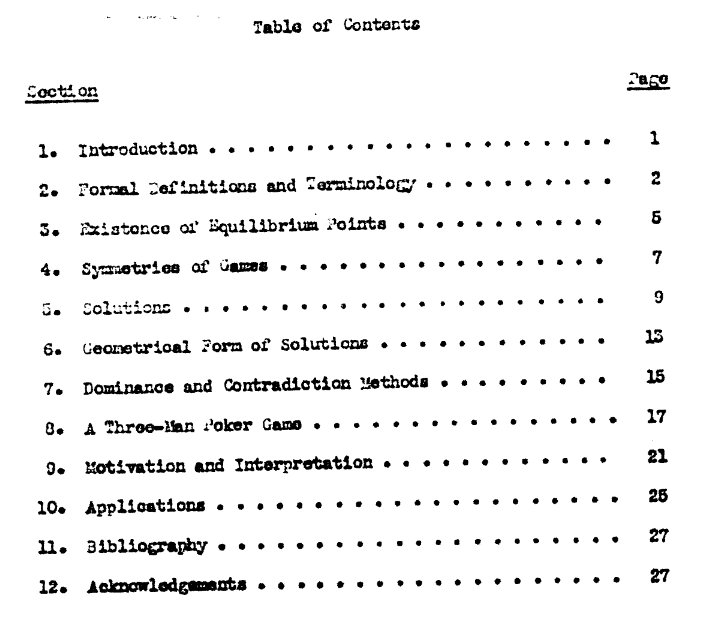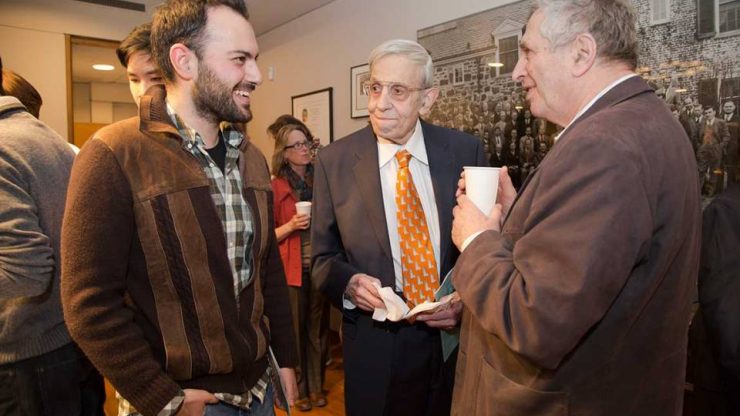The year is 1950. John Nash, a young graduate student at Princeton, submits his PhD dissertation. It’s not a voluminous work stretching into hundreds of pages, as one might expect from groundbreaking research. Instead, it consists of a mere 27 pages. Titled “Non-Cooperative Games,” this unassuming document would go on to revolutionize the field of economics and game theory. As such it eventually earned Nash the Nobel Prize in Economic Sciences in 1994.
A minimalist approach where less is more
Nash’s thesis was unique not just in its length, but also in its reliance on citations. Only two sources were cited in the entire document. The first was the 1944 seminal work “Theory of Games and Economic Behavior” by John von Neumann and Oskar Morgenstern, the book that essentially laid the foundation for game theory.
The second was an article titled “Equilibrium Points in n-Person Games” — authored by none other than John Nash himself. This deliberate selection hinted at Nash’s confidence in his original ideas and his audacity to let them stand almost solely on their own merit.
In academic circles, the importance of a thesis is sometimes measured by its length and the number of citations it carries. Nash defied this unwritten rule in a spectacular manner. It was as if he was saying, “Here are my ideas; they stand on their own.”
The essence of Nash’s brilliance
What made Nash’s dissertation extraordinary was its concept of equilibrium in “non-cooperative” games. A significant departure from traditional theories that primarily focused on “cooperative” games where participants can make binding agreements.
His work argued that in any game involving two or more players, each with their set of strategies, there exists an equilibrium where each player’s strategy is optimal given the strategies chosen by everyone else.
This would come to be known as the “Nash Equilibrium.”
Nash’s theories extended well beyond economics. They found applications in various domains, including biology, political science, and even philosophy. They provided a robust analytical framework to understand how individual decisions in complex systems could ultimately result in a stable, balanced outcome.
Nash’s impact was far-reaching and profound
The magnitude of the impact of Nash’s work can be best understood by the accolades it received. In 1994, nearly five decades after he wrote his thesis, Nash was awarded the Sveriges Riksbank Prize in Economic Sciences in Memory of Alfred Nobel – Nobel prize for Economics. This prestigious recognition signified the immense influence and lasting relevance of his work.

While the 26 pages may have seemed trivial at the time, the depth and breadth of the ideas contained within were far from it. Many researchers and scholars have since built upon Nash’s principles, and his equilibrium concepts have become a standard teaching module in economics courses worldwide.
Paving the way for modern game theory
Before Nash, game theory was an interesting but limited field. His dissertation blew open the doors to various new interpretations and applications. For instance, Nash’s ideas are now routinely applied in everything from market economics to election strategies. You can find them in negotiations, and even evolutionary biology.
His theories are applied in fields as varied as artificial intelligence, where algorithms often use Nash equilibrium concepts for decision-making. They are visible to international politics, where countries apply non-cooperative game theories in diplomatic negotiations and strategy planning. His work even finds applications in evolutionary biology, as mentioned earlier, explaining survival strategies among different species.
A life fraught with challenges — genius, vulnerability and the enigma of recovery
John Nash’s mental health battles are commonly thought to have been a lifelong struggle. However, the truth, as explained by his biographer Sylvia Nasar, paints a more nuanced picture.
Nash experienced the onset of schizophrenia at age 30 and underwent treatment only up to age 40. After that point, he had what he described as “aging out of it.” Nash speculated that hormonal changes played a role in his recovery, a hypothesis that aligns with the principles of cognitive and behavioral therapies that help patients manage delusions rather than will them away.
Nash’s case was exceptional even among those with chronic schizophrenia. He was among the small fraction who experience spontaneous recoveries. Generally, only 8 to 10% of patience experience such recovery.
While his intellectual brilliance was undoubted, another underappreciated aspect of his life was the role his wife Alicia played in his recovery. As Nasar notes, Nash had a stable home and family to return to, providing a sanctuary of sorts that undoubtedly played a role in his well-being.
Hopes and recognition and the Nobel as a crowning achievement and a final cure
The Nobel Prize in 1994 wasn’t just a triumph of intellectual prowess; it served a dual role.
For Nash, the award was a recognition not just from the academic community but also a form of reintegration into a society, The same society that had perhaps distanced itself from him due to his mental illness.
According to Nasar, the Nobel “completed the cure” in the sense that Nash could re-enter a community that, despite years of estrangement, still held significance for him and to which he could contribute anew.
This external validation, while late in coming, offered a sense of closure and belonging. And that cannot be underestimated in understanding Nash’s multifaceted life journey.
The unshakable support of his family and the acknowledgment from a community that had once shunned him combined to provide a form of holistic recovery that is as awe-inspiring as it is rare. Nash’s story isn’t merely one of intellectual triumph but is equally a narrative about the resilience of the human spirit, underscored by the roles of love, belonging, and recognition.
A tale of two narratives — Hollywood vs. Reality
Nash’s life was depicted in the 2001 film “A Beautiful Mind,” inspired by Nash’s life. While the movie captured the essence of Nash’s genius and his battle with schizophrenia, it took several creative liberties.
One such discrepancy is the film’s portrayal of visual hallucinations, which Nash himself did not experience. Moreover, the movie chose to focus on the more dramatic aspects of his condition. At the same time it omitted significant elements of his personal life. For example, his divorce and eventual remarriage to Alicia.
What the film did accurately convey, however, was Nash’s resilience and the unwavering support he received from Alicia. It managed to humanize a man often perceived merely as a towering intellectual figure. It brought to light the everyday battles he fought against his own mind.
A final chapter
The story of John Nash and his wife Alicia took a heartbreaking turn on May 23, 2015. Just shortly after Nash had received the Abel Prize for his contributions to mathematics, the couple died in a car crash while returning home from the airport. It was a shocking and sudden end. Not just to a life marked by incredible highs and lows, but also to a love story that had withstood the test of time, illness, and even separation.
The news of their deaths reverberated across academic circles and beyond, offering a grim reminder of the unpredictability of life. At the time of his passing, Nash was still active in his work, never one to rest on his laurels. His death, therefore, served as a stark full stop to a career that had recently received another accolade, and a life journey that had been marked by extraordinary resilience.
The couple’s sudden departure was an unfortunate punctuation to an enduring narrative of love, perseverance, and intellectual curiosity. As much as Nash’s theories revolutionized economics and mathematics, his life story with Alicia provided a real-world testament to the power of human endurance and connection.
Though they left the world abruptly, the indelible marks both John and Alicia Nash made—on science, on perceptions of mental health, and on each other’s lives—endure as a testament to their shared journey. They may have departed, but their story continues to resonate, serving as a complex but ultimately inspiring legacy.
A lifetime of legacy in 27 pages and a life that stretched its bounds
In the grand arc of John Nash’s life, which was full and long, living to the age of 86, one can see echoes of the succinct but powerful document that made him famous.
His 27-page PhD thesis, “Non Cooperative Games,” was remarkable for distilling complex theories into an understandable, transformative format. Similarly, Nash’s long life was dense with accomplishments and challenges that transcended the years he lived.
While his life did stretch over eight decades, each chapter was marked by a density of experience. From the highs of academic achievements to the lows of mental health struggles, from the love and support of his family to the ultimate, tragic conclusion — each period of his life was as impactful as those concise 27 pages that first put him on the map.
The abrupt ending to Nash’s life was a cruel stroke of fate. However, in no way it diminishes the longevity or significance of his journey. If his thesis taught us that profound ideas don’t need a lot of space to make an impact, his life demonstrated that the impact of human existence isn’t solely measured by its length, but by its depth and the ripples it creates in the world around it.
John Nash did just that. Altered our understanding of the world in a mere 27 pages and shaped a life that, while cut short, was long in its reach and profound in its influence.

Here’s how you can support us
We hope you like our content. You can support us in several ways. If you use ad-blocking software, please consider adding us to a safelist. When sharing our content, please link back to the source. When sharing on Instagram, please tag @viborccom. The same is for Twitter (@viborccom).
Thanks! Hvala! Danke! Дякую!
ABOUT THE AUTHOR
 At 86, Nash (center) continued to inspire and work with younger researchers such as Michail Rassias (left), a Princeton visiting postdoctoral research associate in mathematics who was working on an upcoming book with Nash. (Photo by Danielle Alio, Office of Communications)
At 86, Nash (center) continued to inspire and work with younger researchers such as Michail Rassias (left), a Princeton visiting postdoctoral research associate in mathematics who was working on an upcoming book with Nash. (Photo by Danielle Alio, Office of Communications)











